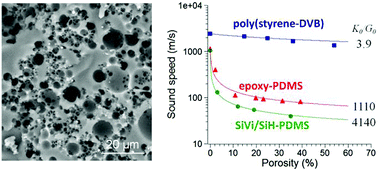Tuning the sound speed in macroporous polymers with a hard or soft matrix†
Abstract
In this paper, we investigate the factors affecting the sound speed in air-filled macroporous polymer materials at ultrasound frequencies. Due to the presence of large proportion of gas, these porous materials present high compressibility and, as a consequence, low sound speed which may fall down to values as low as 40 m s−1. Using an emulsion-templating method, we synthesize macroporous samples with similar porous structures but with three different matrices, i.e. a hard poly(styrene-divinylbenzene (DVB)) matrix, a soft epoxy-modified polydimethylsiloxane (PDMS) matrix and a very soft polyaddition PDMS matrix. We characterize the matrix mechanical properties by measuring both the bulk modulus K0 and the shear modulus G0. Next, we compare the sound speed measured in porous samples with porosity varying from 0 to 50%. We show that, in agreement with theoretical predictions, the sound speed is mainly controlled by two parameters, the porosity value and the K0/G0 ratio of the polymer matrix. These parameters may be used to control the sound propagation in porous polymers, which opens the way to the realization of gradient-index materials.



 Please wait while we load your content...
Please wait while we load your content...